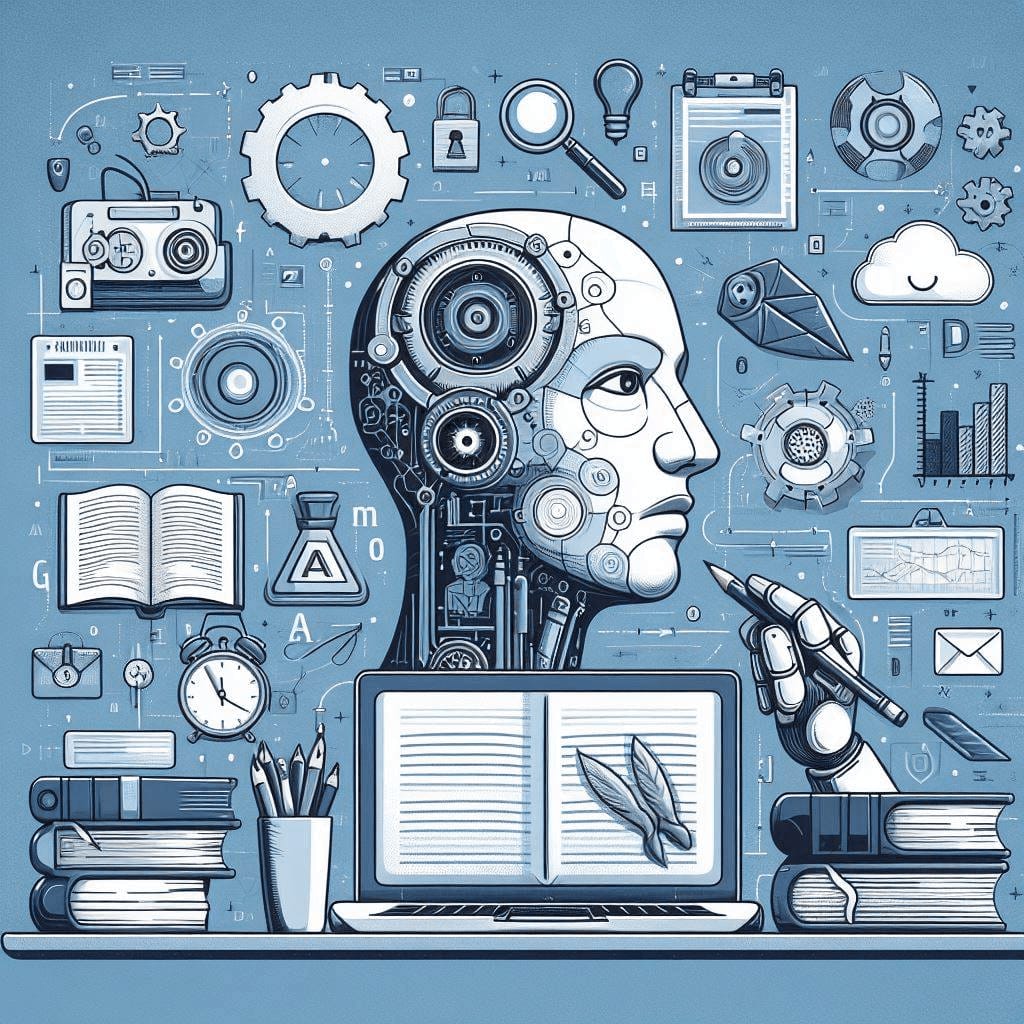Artificial intelligence in education sector emerged as a very highly significant and transformational technological advancement. Academic writing has seen significant advancements and widespread adoption of artificial intelligence (AI) tools and approaches across multiple application domains. AI-based tools for scientific writing are beneficial but also pose some challenges. The scoping study for AID for academic writing comprehensively surveys opportunities and challenges regarding AI in education based on an analysis of literature published within the last 8 years from 2015-2023 on diverse national journal sites. Two categories exist as primary findings. First, the various types of benefits of implementing AI in education for academic writing include improved writing skills, content writing skills and personalized feedback, writing assignment management, multilingual and multicultural support, collaboration and interactive support, and ease of accessibility and inclusion. Second, difficulties in applying AI in education to academic writing include ethics and academic integrity, development of technical AID skills, bias, individual learning, roles, and changes in instruction, assessment and validity, and changes in instructor knowledge and use of AID.
Introduction
The rise of the integration of artificial intelligence into the educational environment, that is artificial intelligence in education (AIDE), is due to how education became more involved due to advances in computing and the methods used in processing information. The emergence of AIDE nearly thirty years ago has positioned AI as a powerful tool to enable novel approaches to instructional design, technological advancement, and educational research that would otherwise be unattainable within traditional educational frameworks. Artificial Intelligence in Education (AIDE) has presented novel possibilities, potential, and obstacles to educational advancement. For example, it has facilitated the transition toward individualized learning, posed challenges to the traditional job of instructors, and contributed to the development of complex educational systems. While there is great potential for artificial intelligence (AI) to revolutionize the field of education, it is important to note that achieving positive educational outcomes cannot be attributed solely to the use of modern AI computer technologies. A primary purpose of artificial intelligence (AI) in education is to offer learning guidance or support to students on an individual basis, taking into account their unique learning conditions, preferences, and personal qualities.
The importance of incorporating the knowledge and intelligence of experienced teachers into the decision-making process of learning systems is a key concern within the framework of precision education. This types of educational approach emphasizes the provision of prevention and intervention practices tailored to the specific needs of an individual learner through the use of assessments of their learning status or behavior, according to Hart (2016). The use of artificial intelligence in education has brought various types of new opportunities for the development of technology-driven learning tools and settings to produce the most effective experiences in learning and for the development of technology-driven learning tools and settings. However, it has been a challenge for most researchers and practitioners who have been taught in the field education to implement appropriate activities or systems. According to Mitchell (2019), “The design and development of the next generation of AI tools for students, teachers, and systems should be focused on human concerns and problem solving.”
It is recommended to begin by giving a concise and clear characterization of the definition of challenges and opportunities in education. The use of AI tools in education, in itself, should be geared towards enhancing the role of teachers rather than diminishing their professional standing or dignity. Developers should realize that the educational process is ever-evolving and inherently uncertain. Simply adapting learning content to suit an individual does not guarantee the use of the most efficient pedagogical approach or the facilitation of self-actualization for the student. Artificial Intelligence (AI) has the potential to uncover previously undiscovered learning patterns within vast datasets, thereby providing valuable insights. However, AI lacks the ability to facilitate physical and social interactions between students and between students and teachers, as well as the ability to fully express the diverse range of human experiences.
Several research groups have conducted several systematic reviews with the intention of drawing attention to a persistent problem in the field of AID. The problem is related to the fact that there is not enough academic work that takes into account all the challenges and benefits of artificial intelligence in the education sector. Zawacki-Richter et al. (2019) conducted a comprehensive examination of 146 scientific works related to the application of artificial intelligence (AI) within the scope of higher education. The results of their study indicated a lack of in-depth analysis on the theoretical, pedagogical, and ethical implications arising from the implementation of AI technologies in higher education institutions. In a comprehensive research conducted by Deva et al., 2021 analyzed 109 scientific articles about automated feedback systems. The researches showed that most of the articles and publications considered for their research fail to mention and analyze the available challenges and opportunities related to artificial intelligence application within the academic community, particularly towards academic writing.
Of specific importance is the extrapolation of these theories and frameworks, as they play a key role in the understanding of implementation factors that influence the acceptance and use of these systems. In order to develop a deeper understanding of the diverse barriers and possibilities associated with artificial intelligence (AI) technology in the field of education, it is important to analyze these findings, with a specific focus on the efficient use of AI in education in the context of academic writing. There are two broad groups into which the use of AI in education for the field of academic writing can be divided: tools that assist writers in all stages of writing, and systems used to review and evaluate the quality and validity of written output.
Tools such as natural language processing have the potential to assist writers in the composition and preparation of manuscripts by facilitating the understanding and generation of language that resembles human speech. One of the most significant advantages inherent in AI-based tools for academic writing lies in their ability to increase efficiency and accelerate the completion of tasks, hence resulting in time savings. Accordingly using AI for writing in an academic setting raises a number of ethical dilemmas and concerns. On the one hand, the employment of AI may compromise the effectiveness of student learning assessment and devalue a diploma. As shown by students cannot learn the material well if they are not involved in the learning process and instead rely on AI to do all the work for them. They will be less able to proceed with the following tasks. Furthermore, students will be able to be baffled and undeterred by the use of AI. Thus, it is necessary to conduct further review studies to use a scoping review of the available literature, and thus provide an integrated analysis of the possibilities and challenges of artificial intelligence in education (AID).
Read Also:
- Artificial Intelligence (AI) In Agriculture: Current Status And Future Need
- A Glimpse About Artificial Intelligence (AI) In Agriculture
- Benefits And Challenges Of Artificial Intelligence (AI) In Agriculture
- Artificial Intelligence In Agriculture
- The Potential Of Artificial Intelligence In Finance
- Artificial Intelligence (AI) Advanced Interactive Systems
- Artificial Intelligence (AI)-Driven Applications
- The Real Facts About Artificial Intelligence
- Potential Of Artificial Intelligence (AI) In Healthcare
- Artificial Intelligence (AI) In Diagnosis And Treatment








Leave a Reply